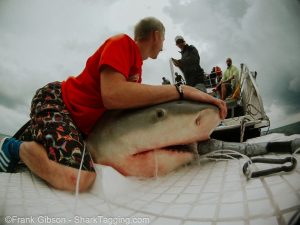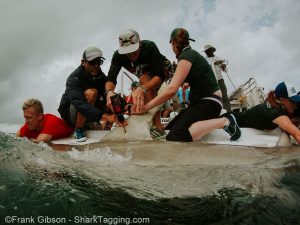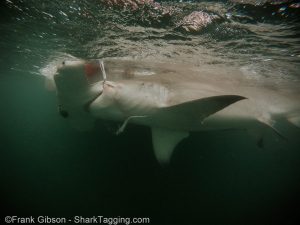Shark Tagging with Felix Varela Senior High School
By Shannon Moorhead, SRC Intern
On Saturday March 5th, the SRC team was joined by students and faculty from Felix Varela Senior High School- and what a day it was! When I arrived at Crandon Marina, I was afraid that questionable weather would keep us inshore, but our trip leader settled on a location: Soldier Key in Biscayne National Park, right on the edge of where Biscayne Bay meets the Atlantic Ocean. It was a spot I had never been to, but my teammates claimed to have caught some very interesting things there, so I was quite excited. The team loaded up the boat and once our guests arrived and the pre-trip introductions were completed, we were off!
When we arrived at Soldier Key, the team deployed our fish trap and the first set of ten drumlines in about ten feet of water. While we waited for the lines to soak, our trip leader Jake Jerome briefed the students on the shark workup procedure and how they would be helping us tag the shark and collect data. The first, and very important, data collection the students helped with was “environmentals”: recordings of the temperature, salinity, and dissolved oxygen content of the seawater around our site. Environmental data is recorded for each set of lines deployed and can give us important insight into factors that may significantly affect shark abundance in the localized area. Once this was complete and the lines had soaked for an hour, we went to retrieve our first set!
The decision to go to Soldier Key immediately paid off when we pulled up a male nurse shark on the very first line! I had the great honor of “jumping head” on this shark, which means I was responsible for keeping its head in place. I never realized how difficult the job was: this shark would not stop moving and it took four of us to secure him to the platform! Once he had settled down, the Varela high students assisted us with the working up the shark, while SRC team members drew blood and took morphological measurements. First, students helped us measure the shark, which came out to 231 cm, about 7 and a half feet! Next, a mark-recapture tag was inserted just beneath the shark’s dorsal fin: this will let us know if we catch the shark again and has the lab’s phone number on it so fishermen can contact us, and hopefully provide us with some data, if they catch the shark. Finally, a student took a small clipping of the shark’s dorsal fin, which can provide us with information on what the shark is eating via stable isotope analysis. When the process was complete, the shark was released back into the water and we moved on to the second line.
![A Varela High student helps insert a mark-recapture tag into a nurse shark.]](https://sharkresearch.rsmas.miami.edu/wp-content/uploads/2016/03/PIC-1-225x300.jpg)
A Varela High student helps insert a mark-recapture tag into a nurse shark.
But the fun didn’t stop there: on the second line we discovered a gigantic bull shark! The likely pregnant female was a struggle to get onto the boat, because of how heavy she was, but was very cooperative once we had lifted her on to the platform. She was so big that when Jake tried to switch to the other side of the shark I had to lift his leg over the dorsal fin for him because he couldn’t get it high enough! The big girl measured 287 centimeters, almost 9 and a half feet! After a quick workup, we got her back in the water and retrieved the rest of the first set, but unfortunately there were no more sharks to be seen. We reset the lines and the waiting began again.

SRC graduate student Jake Jerome keeps the head of this massive female bull shark secure during the workup procedure.
When we went to pick up the first drumline of the second set, we ran into a slight problem: we couldn’t find it! After a brief search, we found the line #1 a quarter mile from where we had set it tangled with a crab trap. The team and I were getting very excited; whatever had dragged our 40 pound drum a quarter mile must be huge. And it was: as we pulled in the line a massive female great hammerhead slowly rose to the surface! Once she was alongside the boat, SRC members took charge on the workup. Our lab’s research has found that hammerheads get stressed more quickly than other shark species so during the workup the shark is left in the water and the workup is performed by the SRC staff to make sure it goes as quickly and smoothly as possible. In the interest of time, the shark was not measured, but the team estimated she was 13 feet long because she was longer than our 12 foot platform! Luckily, the team had time to attach an external acoustic tag to the shark’s dorsal fin. Acoustic tags send out a ping which can be picked up by receivers placed underwater around Florida and along the east coast by SRC and other labs. This gives us extremely valuable information about the movement patterns of this highly migratory species. Once the tag was attached this beautiful behemoth of a shark was released successfully!


View from above and below the water as SRC graduate student Robbie Roemer prepares to fix this great hammerhead shark with an external acoustic tag.
We reset line #1 and hauled in and redeployed the rest of set 2, on which there were no more sharks. Set number 3 and our fish traps came up empty as well, but we weren’t very disappointed. It may have only been a three shark day, but we were thrilled. For several of us, those were the largest bull shark and largest hammerhead we had ever seen! The students of Varela High seemed to share our excitement: not every day you get up close and personal with animals of that size! It was an awesome trip, thanks to Varela High for the help and enthusiasm, can’t wait to have you guys out again!

Thanks for a great day Varela High!
